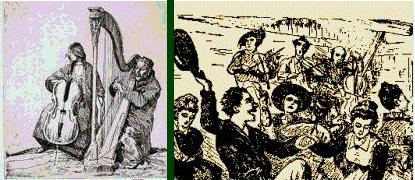To aid in the discussion, Dr. Collins identifies five equidistant string Contact Points on the instrument - from very near the bridge to the end of the fingerboard. Identification of these contact points help teacher-student communication and assist the student in understanding which points on a string are associated with particular tonal qualities and the max/min limits of speed and pressure.
On a related "note", Dr. Collins has also discussed the Simon Fischer Secrets of Tone Production DVD (Which I have, by the way, and have gone through the exercises with my own teacher). Yes, between the diagram and the exercises, one certainly gets a better feel of how to control what happens between the bow hair and the string! My feeling is, for the price of a single in-person lesson, one has hours of DVD material to work with, take to the teacher, discuss, periodically review, and continuously incorporate into one's daily playing.
But now back to the Schelleng diagram. Below is an example as normally presented:

The Schelleng diagram has some intriguing characteristics for the well-trained acoustic scientist. But as a lowly cello student and non-scientist (but a former good high school math student 40+ years ago), I have some suggested changes to the Schelleng Diagram for helping to provide an intuitive understanding of the pressure/point-of-contact relationship.
At a casual glance, one would think the horizontal axis represents linear distance on the violin string, but that is not actually the case.
If I look at the numbers on the horizontal axis, I see tick marks at .7, 1.4, 2.8, 4.2, 7, and 14 centimeters (cm). Each mark is basically twice the distance from the bridge of the previous mark. That tells me the horizontal axis is on a logarithmic scale (base 2, in this case). On a violin, the 2.8 cm mark is ok, it corresponds to somewhere between Contact Point 2 and 3, but 7 cm mark is well over the fingerboard (the fingerboard ends at 5.5) and the 14 cm mark is near the mid-point of an open string. Scientifically this is interesting, but no musician reasonably bows a violin string near the mid-point.
Also at a casual glance, one would also think the vertical axis is a straight-forward linear representation of bow force. Actually, each mark is 10 times more forceful than the mark below it: .001, .01, .1 and 1. So that scale is also logarithmic (base 10, in this case). The bow force on the line at the top of the chart is greater than the line at the bottom by 1000 times!
So what I did was re-create the Schelleng diagram in an Excel workbook by plugging in some sample X-Y values and mapping them on a chart until I had something that approximate matched the original diagram:
 Since I don't have raw data values, and the original diagram itself is an approximation, we should realize that this re-creation is only approximate. Also, in real life, with real instruments, and real bows, and real strings, and real rosin, and real players, these values can vary some.
Since I don't have raw data values, and the original diagram itself is an approximation, we should realize that this re-creation is only approximate. Also, in real life, with real instruments, and real bows, and real strings, and real rosin, and real players, these values can vary some.Keeping the internal data the same, I took the chart and changed the vertical axis from log 10 to linear, and the horizontal axis from log 2 to linear. I then drew in vertical lines to represent the locations of the five Contact Points. And lastly, I reversed the axes with the idea it might be intuitively clearer to a violin or viola player if the contact points go from left to right, just as they do when holding an instrument:
 I think this diagram provides a more intuitively clear picture of the pressure/point-of-contact relationship, as it actually feels. We can also see from this diagram that at Contact Point 2 we have the most widest range between maximum and minimum bow force. As we bow closer to the bridge, we must greatly increase pressure and become very precise in the placement of our contact point - very little room for error. Whereas we can see the difference in the max/min pressure between Contact Points 4 and 5 is really quite small.
I think this diagram provides a more intuitively clear picture of the pressure/point-of-contact relationship, as it actually feels. We can also see from this diagram that at Contact Point 2 we have the most widest range between maximum and minimum bow force. As we bow closer to the bridge, we must greatly increase pressure and become very precise in the placement of our contact point - very little room for error. Whereas we can see the difference in the max/min pressure between Contact Points 4 and 5 is really quite small.So the question is, does this revised diagram correspond to your own sensations and feelings, or might you suggest even other changes?
